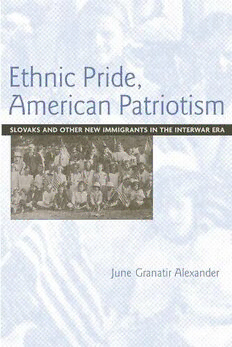
Ethnic Pride, American Patriotism: Slovaks And Other New Immigrants In The Interwar Era PDF
Preview Ethnic Pride, American Patriotism: Slovaks And Other New Immigrants In The Interwar Era
Ethnic Pride, American Patriotism Slovaks and Other New Immigrants in the Interwar Era Ethnic Pride, American Patriotism Slovaks and Other New Immigrants in the Interwar Era JUNE GRANATIR ALEXANDER TEMPLE UNIVERSITY PRESS Philadelphia Temple University Press 1601 North Broad Street Philadelphia PA19122 www.temple.edu/tempress Copyright © 2004 by Temple University All rights reserved Published 2004 Printed in the United States of America The paper used in this publication meets the requirements of the American National Standard for Information Sciences—Permanence of Paper for Printed Library Materials, ANSI Z39.48-1992 Library of Congress Cataloging-in-Publication Data Alexander, June Granatir, 1948– Ethnic pride, American patriotism : Slovaks and other new immigrants in the interwar era / June Granatir Alexander. p. cm. Includes bibliographical references and index. ISBN 1-59213-251-0 (cl.) — ISBN 1-59213-252-9 (pbk.) 1. Slovak Americans—Politics and government. 2. Slovak Americans— Ethnic identity. 3. East European Americans—Politics and government. 4. East European Americans—Ethnic identity. 5. United States—Emigration and immigration—History—20th century. I. Title. E184.S64A415 2004 973'.049187–dc22 2003064568 2 4 6 8 9 7 5 3 1 For John with love and gratitude Contents Preface and Acknowledgments ix Introduction: Getting a Perspective on “New Immigrant” America 1 I. THE TRANSATLANTIC YEARS: WORLD WAR I TO 1924 1 Hyphenates and Patriots: An Ethnic Perspective on the Great War 15 2 Unfinished Business: The Homeland, National Identity, and Americanization 44 3 Memories, Principles, and Reality: The Postwar Era to 1924 70 II. TURNING INWARD: 1924 THROUGH WORLD WAR II 4 Manifesting Pride, Power, and Patriotism: Nationality Days in Local Communities 93 5 Maintaining an Ethnic Image: Fashioning Nationality Days for Local Youths 114 6 Language and Leisure: Getting the Younger Generation’s Perspective 132 7 Beyond the Generations: Ethnic Activism and Class Interest in the 1930s 160 8 The Triumph of Principles: National Unity and Ethnic Activism in World War II 192 viii CONTENTS Conclusion: Persistent Issues and New Perspectives 220 Abbreviations 227 Bibliographical Note 229 Notes 233 Index 273 Preface and Acknowledgments HISTORYTAKESODDTWISTSand turns and so, too, does the writ- ing of history. This project started more than a decade ago as a com- parative investigation of ethnic groups during the Great Depression, an era that, fifteen years ago, studies of immigration and ethnicity had generally neglected. Initial attempts to conceptualize the resultant research compelled me to admit that, rather than exploring the past, I had been dictating to it. The questions I was asking reflected the then current state of scholarly studies and, instead of letting history speak to me, I was superimposing contemporary fascinations as well as my own interests on immigrants and their children who lived through the inter- war era. As a result, I shifted my approach to focus on group-generated activities and broadened the chronological time frame. The growing scholarship on U.S. and ethnic history has helped sharpen my inquiry, but the burgeoning research on “whiteness” was the only scholarship that unavoidably forced its way into my reevaluation. My reassessment also stemmed in part from a growing—if reluctant— willingness to admit that my own life experience was not only a valid influence on my interpretation of the past, it offered insight. Raised in a family with parents of ethnically different backgrounds (one of east- ern European ancestry; the other of mixed northern European heritage), inculcating an ethnic identity was not part of my or my siblings’ up- bringing. Yet looking back on those years, it is patently obvious that ethnicity was evident everywhere. It was there in the various holiday traditions upheld by nuclear and extended families. It was apparent in life-cycle events when weddings, funerals, and religious rituals invari- ably included people who spoke English laden with heavy accents and who reminisced about the land where they had been born and what life “in America” had been like. On a community-wide scale, ethnicity was visible in the nationality schools, which in the 1950s still existed in this industrial region stretching along the banks of the Ohio River. Many, albeit not all, second-generation parents enrolled their offspring in these nationality institutions, where admission was based on ethnic background. These were adults who, if
